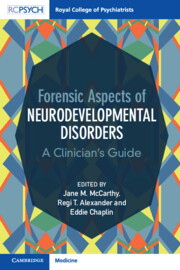Book contents
- Forensic Aspects of Neurodevelopmental Disorders
- Forensic Aspects of Neurodevelopmental Disorders
- Copyright page
- About the Cover Page
- Contents
- Contributors
- Foreword by the Rt Hon Lord Bradley
- Terminology Used in the Book
- Section 1 An Overview: Definitions, Epidemiology and Policy Issues
- Section 2 Assessment and Therapeutic Approach
- Chapter 11 Attention Deficit Hyperactivity Disorder: Assessment and Therapeutic Approaches within Forensic Settings
- Chapter 12 Autism Spectrum Disorder: Assessment and Therapeutic Approaches within Forensic Settings
- Chapter 13 Intellectual Disability: Assessment and Therapeutic Approaches within Forensic Settings
- Chapter 14 Risk Assessments in People with Neurodevelopmental Disorders
- Chapter 15 Assessment and Treatment of Young Offenders
- Section 3 Criminal Justice Pathways and Legal Issues
- Index
- References
Chapter 13 - Intellectual Disability: Assessment and Therapeutic Approaches within Forensic Settings
from Section 2 - Assessment and Therapeutic Approach
Published online by Cambridge University Press: 18 May 2023
- Forensic Aspects of Neurodevelopmental Disorders
- Forensic Aspects of Neurodevelopmental Disorders
- Copyright page
- About the Cover Page
- Contents
- Contributors
- Foreword by the Rt Hon Lord Bradley
- Terminology Used in the Book
- Section 1 An Overview: Definitions, Epidemiology and Policy Issues
- Section 2 Assessment and Therapeutic Approach
- Chapter 11 Attention Deficit Hyperactivity Disorder: Assessment and Therapeutic Approaches within Forensic Settings
- Chapter 12 Autism Spectrum Disorder: Assessment and Therapeutic Approaches within Forensic Settings
- Chapter 13 Intellectual Disability: Assessment and Therapeutic Approaches within Forensic Settings
- Chapter 14 Risk Assessments in People with Neurodevelopmental Disorders
- Chapter 15 Assessment and Treatment of Young Offenders
- Section 3 Criminal Justice Pathways and Legal Issues
- Index
- References
Summary
The prevalence of intellectual disability (ID) in offender services is higher than in the general population. Identifying offenders with ID in the criminal justice system can be a challenge. It is essential to recognise offenders who may have ID and assess them. Screening offenders for ID is potentially less time consuming and effective in identifying those who would benefit from full assessment. Screening tools such as the LDSQ and HASI have been developed in community and in forensic settings, which have good sensitivity and specificity. Screening for adaptive functioning skills is important when considering the presence of ID that may be difficult to elucidate in a forensic setting. The treatment of offenders with ID requires commitment from staff to support people through levels of security. Adapting treatment strategies is key to treating people. Treatment programmes for offences such as sex offences, fire setting and violence can be adapted successfully to work with people with cognitive impairments. Alternatives to custodial and hospital care are developing where people are diverted from prison to hospital or to appropriate community support.
Keywords
- Type
- Chapter
- Information
- Forensic Aspects of Neurodevelopmental DisordersA Clinician's Guide, pp. 148 - 163Publisher: Cambridge University PressPrint publication year: 2023



